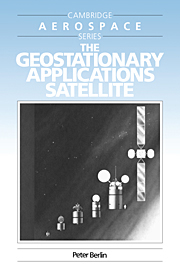Book contents
- Frontmatter
- Contents
- Dedication
- Preface
- List of Acronyms
- 1 Launch vehicles
- 2 The transfer orbit
- 3 The geostationary orbit
- 4 The satellite environment
- 5 Structures
- 6 Mechanisms
- 7 Thermal control
- 8 Power supply and conditioning
- 9 Propulsion and orbit control
- 10 Attitude stabilization, measurement and control
- 11 Telemetry, tracking and command (TT&C)
- 12 Communications payload
- 13 Meteorological payload
- 14 Product assurance
- 15 Spacecraft development and testing
- Index
- Frontmatter
- Contents
- Dedication
- Preface
- List of Acronyms
- 1 Launch vehicles
- 2 The transfer orbit
- 3 The geostationary orbit
- 4 The satellite environment
- 5 Structures
- 6 Mechanisms
- 7 Thermal control
- 8 Power supply and conditioning
- 9 Propulsion and orbit control
- 10 Attitude stabilization, measurement and control
- 11 Telemetry, tracking and command (TT&C)
- 12 Communications payload
- 13 Meteorological payload
- 14 Product assurance
- 15 Spacecraft development and testing
- Index
Summary
Introduction
The structure is the skeleton of a satellite. The primary design criterion for a satellite structure is that it should be rigid enough to survive the launch ascent phase while being as light and compact as possible. Low weight usually means lower launch cost, and small volume is necessary if the satellite is to fit inside the confines of the launcher fairing. Perhaps the day will come when satellites are assembled not on the ground but in orbiting space stations, in which case this fundamental design criterion will become far less onerous.
A secondary criterion is that flimsy structures such as solar panels and antennae should suffer a minimum of deformation under the influence of dynamic forces and thermal stresses in geostationary orbit. Panels have a tendency to twist during attitude manoeuvres and could actually counteract the intended movements. Parabolic antenna reflectors may change geometry due to thermal stresses as the solar incidence angle varies; the result could be a loss in antenna gain due to defocussing.
The structure must also be sufficiently stiff to prevent permanent misalignment of highly directive equipment such as antennae, thrusters and attitude sensors. In this chapter we will study the architecture of a typical geostationary satellite structure, make an inventory of materials used, follow the design logic, and discuss a mathematical modelling method.
Structure Architecture
A fairly typical geostationary satellite structure is shown in Fig. 5.1. It is made up of a primary structure, a secondary structure and various appendages.
- Type
- Chapter
- Information
- The Geostationary Applications Satellite , pp. 73 - 78Publisher: Cambridge University PressPrint publication year: 1988



